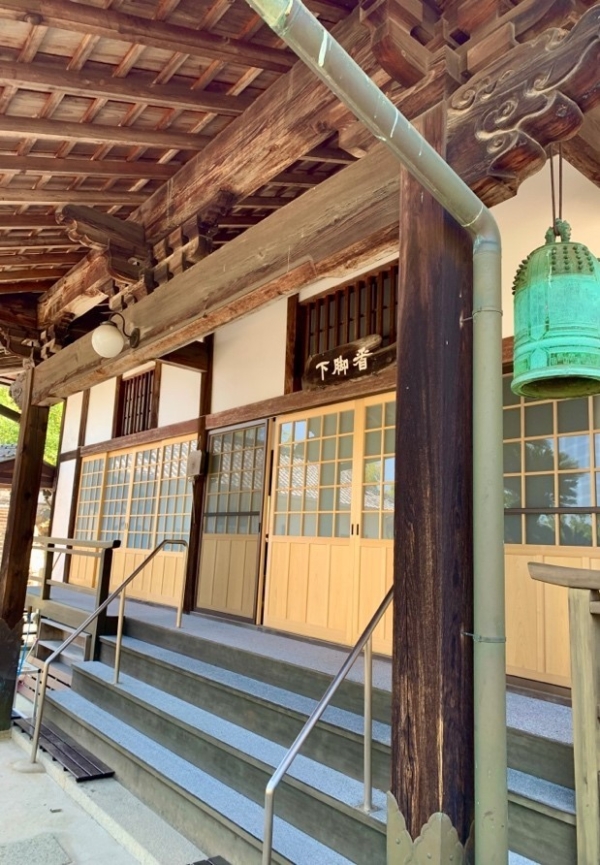Peaceful atmosphere lingering around, quaint vivid painting on the ceiling, home to the natural and cultural heritage on the island… Osakikamijima maintains its peace for the tranquil and sacred temple of Amidaji, allowing visitors to embrace Buddhist culture.
Welcome to our Island Youth Blog! This is Tsuyoshi Hasegawa; now I will be introducing the oldest Buddhist temple on the island—Amidaji!
Amidaji was established in 1422, standing solidly until now. The name of the temple has a good meaning, which comes from Amida Buddha (Amitābha), who is the principal Buddha of Pure Land Buddhism. Amitābha is known for his longevity, discernment, pure perception, and the purification of aggregates with a deep awareness of the emptiness of all phenomena.
Stepping into the temple, there is a house on the left side only for offering Jizo Bodhisattva (Kṣitigarbha), who is known for his vow not to achieve Buddhahood until all hells are emptied. He is therefore often regarded as the bodhisattva of hell-beings, as well as the guardian of children and patron deity of deceased children and aborted fetuses in Japanese culture. As I opened the door, a big stone statue of Jizo Bodhisattva solemnly stood in front of me, filling me with a sense of awe and respect. Additionally, there are nine paintings of hell on the ceiling.
Here is the second painting among those nine, which is right above the stone statue of Jizo Bodhisattva. This painting generates a vivid image of ‘Sai No Kawara’. A river is said to be a place where children who die before their parents suffer as punishment for their unfilial piety. When such children complete a cairn or stone tower to memorialize their parents. However, it is said that a demon will come and destroy the tower before it is completed. Then children would build the tower again and again, and the demon would destroy it again and again. Due to this popular belief, the term “Sai No Kawara” is also used to mean “unrewarded efforts” or “futile labor” in Japanese. However, it is said that the children will eventually be saved by Jizo Bodhisattva. But in this case, it is based on Japanese traditional folk beliefs and has no inherent connection with the original Buddhism. This embodies that this temple not only contains Buddhist culture but also pervades Japanese heritage.

Turning right, the biggest construction in the temple appears. I felt refresh through the perfect combination of the house, tree, and flowers make the temple’s appearance manifests its lively with the bamboo forest outside.

Before opening the door, I noticed something was written above the door. I lifted my head like a sunflower turning towards the sun, all I saw was one word: “看脚下”( Kankyakka). Which is an allusion to an ancient story in China: There was once a monk named ‘Fǎ Yǎn’ who was on the way back to his temple with his three disciples at night. Suddenly, a wind blew the light out, turning it completely dark. At that moment, Fǎ Yǎn asked his disciples to tell him what’s on their minds. First, a disciple named ‘Fó jiàn’ replied, “This darkness, where everything is black, is, on the contrary, like a beautiful red bird dancing in the bright red sky at sunset. The implication here is: life is pitch black and we don’t know what lies ahead, but there is such a thing as a brilliantly colorful life, and brilliantly colorful beings walk through it, so even if we can’t see what’s ahead, we should just move forward step by step with confidence. His words are really deep. But that’s not what the master wants. Then, a disciple named fǒ yǎn answered: “In the pitch dark, this winding road is like a great black snake lying on its side.” Which indicates Since we are in darkness and can’t see what’s ahead, let’s just live in misfortune without thinking too much about how unhappy we are.” That’s also not what the master wants. Finally, ‘Fó guǒ’ answered: “Look under your feet.” In other words, “It is dark and dangerous, so watch your steps carefully to avoid tripping. Fó guǒ’s words were so well received that the master exclaimed, “That’s right, that’s right.” The word he said not only presents its literal meaning but also contains a deep implication. While looking at our steps, reflect deeply on the way we live our life, we want to look at the shortcomings of our life at the same time, recognize and discover our own immaturity… There is such an important meaning in watching our steps. Perhaps this allows us to look at life in a slightly different way.
Upon entering the building, several statues stand solidly with impressive paintings on the wall. The building itself also connects to the monk’s quarters. Luxurious furniture is nowhere to be found here. Instead, simple, old furnishings and walls adorned with ancient poems create a serene atmosphere. Further manifesting monks’ pursuit of the practice of spirituality rather than material possessions.
Here are some tips for a respectful visit: Maintain a sense of awe, keep quiet, find inner peace, and no photography of statues. If you’re interested in exploring this sacred temple and immersing yourself in its culture, a convenient option is the island’s demand bus. Simply set your drop-off location to ‘054_Ohara Assembly Hall’. From there, you can easily find the temple by following the on-site instructions. For detailed instructions on reserving the demand bus, please refer to our previous blog. I hope you enjoy your time and find your inner peace at Amidaji!
大崎上島で最も穏やかな場所 阿弥陀寺
のどかな雰囲気が漂い、天井には趣のある鮮やかな絵が描かれ、島の自然と文化がある…大崎上島は、静かで神聖な阿弥陀寺のために平和を保ち、訪れる人々に仏教の教えを説いてくれます。
みなさんこんにちは、青春旅ブログへようこそ!馳川毅です!今回のブログでは島で一番古いお寺、阿弥陀寺を紹介します。
阿弥陀寺は1422年に創建され現在に至ります。阿弥陀寺の名前は、浄土真宗の本尊である阿弥陀如来に由来されています。
お寺に一歩足を踏み入れると、左手に地蔵菩薩を供養するための建物があります。地蔵菩薩は、すべての地獄が空になるまで成仏しないという誓いを立てたことで知られています。そのため、日本の文化では子供を守護する存在として信仰されていました。
扉を開けると、大きな地蔵菩薩の石像が厳かに私の前に立ちはだかり、尊敬の念と畏敬の念でいっぱいになりました。さらに、天井には九枚の迫力のある地獄絵が描かれています。
この写真は、地蔵菩薩の石像の真上にある九枚の絵のうちの一枚です。この絵は、親より先に亡くなってしまった子供の霊が行く場所とされる冥界の河原「賽の河原」を描いています。しかし、この話は日本の伝統的な民間信仰に基づいており、このお寺は仏教文化だけでなく、日本の遺産を体現しています。
右に曲がると、お寺の中で一番大きな建物に差し掛かります。本堂と、その周りに咲きあふれる木花の調和は、境内の周りの自然とも一体感を作り出しており、とても心が落ち着きます。
本堂の扉を開けようとした直前、ふと、扉の上に何か書かれているのに気がつきました。見上げると、「看脚下」という文字が大きく書かれています。皮肉にも、「看脚下」には、「心を美しく落ち着かせるには足下を見よ」という意味があり、古代中国の逸話に基づきます。中国育ちの自分にとって、こういった自分のルーツにつながるようなものを日本でみることができ、自分の人生を客観視することができます。
ではここで、大崎上島の阿弥陀寺を見学するためのヒントを読者の皆さんに伝えたいと思います:畏敬の念を持ち、静かにし、心穏やかに見学すること。
こん神聖な寺院を探索し、その文化に浸ることに興味があるなら、島のデマンドバスを利用するととても便利です、降車場所を「054_大原集会所」に設定するだけ!そこからは現地の案内に従うと、簡単に寺院を見つけることができます。
デマンドバスの詳しい予約方法は、以前書いたブログをご参照ください。
阿弥陀寺での時間を楽しみ、心の平穏を見つけられることを願っています!
References
“大乗仏教の如来の一つ.” Wikipedia.org, ウィキメディア財団, 26 June 2003, https://ja.wikipedia.org/wiki/%E9%98%BF%E5%BC%A5%E9%99%80%E5%A6%82%E6%9D%A5
to, Contributors. “此岸と彼岸の境にあるとされる川.” Wikipedia.org, ウィキメディア財団, 11 July 2005, https://ja.wikipedia.org/wiki/%E4%B8%89%E9%80%94%E5%B7%9D
“仏教の信仰対象である菩薩の一尊.” Wikipedia.org, ウィキメディア財団, 19 Feb. 2004, https://ja.wikipedia.org/wiki/%E5%9C%B0%E8%94%B5%E8%8F%A9%E8%96%A9
“001 看脚下(かんきゃっか) | 法話の窓 | 法話アーカイブ | 若者へ.” 妙心寺, www.myoshinji.or.jp/houwa/archive/youth/001.
“看脚下 | 臨済宗大本山 円覚寺.” Www.engakuji.or.jp, www.engakuji.or.jp/blog/35245/.


